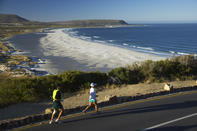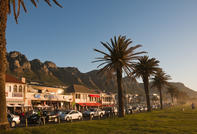Roads Around the Cape Peninsula
By 1913, motorised transport was becoming quite common in the Cape. However, there still weren’t that many roads around the Cape Peninsula. There was access to Hout Bay via Constantia Nek or Victoria Drive, and Main Road ran along the landward side of Table Mountain down to Simon’s Town. But there was no road joining False Bay to the Atlantic Seaboard.

Then, with a diplomatic flourish, it was decided that an ‘All Round the Cape Peninsula Road’ should be constructed. This project was generously funded by the national government (perhaps as compensation for moving the national capital to Pretoria), and work soon began on an assortment of new roads.
De Waal Drive, Red Hill Drive, the road from Simon’s Town to Cape Point, the road from Kommetjie to Cape Point, and Chapman’s Peak Drive from Hout Bay to Noordhoek were all built during this time, using convict labour, and a road harness was subsequently thrown around the muzzle of the Cape Peninsula.
Around the Coast North to South

Drive around the Cape Peninsula and you'll see why Cape Town is regarded as one of the most beautiful cities in the world (or rather, a city with one of the most beautiful locations). Leave the City Bowl and head south through the leafy suburbs along De Waal Drive. In Lakeside, take Boyes Drive with its breathtaking views of False Bay. Follow the shore through the picturesque harbour towns of Kalk Bay and Simon's Town all the way to Cape Point, the southwestern tip of Africa (and no, the Indian and Atlantic oceans do not meet here; they do that at Agulhas).
Return to the City Bowl along the Atlantic Seaboard through Kommetjie and Noordhoek, and along the spectacular Chapman's Peak toll road. The last stretch is through Hout Bay and along the foot of the 12 Apostles peaks and Lion's Head whose lower slopes are dotted with the glamorous suburbs of Llandudno, Camps Bay and Clifton, where the rich come to play. Stop at Clifton Beach to see how long it takes for your toes to go numb in the freezing water.
 Lying at the south-western tip of Africa, the Cape Peninsula is on the Atlantic side of South Africa. A spectacular view of the Cape Peninsu...
Lying at the south-western tip of Africa, the Cape Peninsula is on the Atlantic side of South Africa. A spectacular view of the Cape Peninsu...